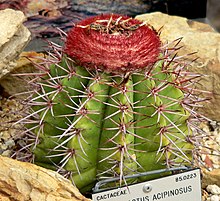bio.wikisort.org - Plantae
Melocactus Link & Otto è un genere di piante succulente della famiglia delle Cactacee, diffuso nell'ecozona neotropicale.[1]
| Melocactus | |
|---|---|
 | |
| Classificazione APG IV | |
| Dominio | Eukaryota |
| Regno | Plantae |
| (clade) | Angiosperme |
| (clade) | Mesangiosperme |
| (clade) | Eudicotiledoni |
| (clade) | Eudicotiledoni centrali |
| (clade) | Superasteridi |
| Ordine | Caryophyllales |
| Famiglia | Cactaceae |
| Sottofamiglia | Cactoideae |
| Tribù | Cereeae |
| Sottotribù | Cereinae |
| Genere | Melocactus Link & Otto |
| Classificazione Cronquist | |
| Dominio | Eukaryota |
| Regno | Plantae |
| Divisione | Magnoliophyta |
| Classe | Magnoliopsida |
| Ordine | Caryophyllales |
| Famiglia | Cactaceae |
| Genere | Melocactus |
| Specie | |
Descrizione
I fusti hanno forma simile a tutte le comuni cactacee; sono di colore verde e presentano costolature con areole più o meno spinose.
Il nome deriva dal latino melo (melone) unito a cactus, data la forma del fusto che presenta all'apice una forma globulare o cilindrica detta "cefalio"; questo inizialmente si presenta emisferico e prende poi forma cilindrica quando raggiunge la crescita.
Tassonomia
Ol genere comprende le seguenti specie[1]
- Melocactus × albicephalus Buining & Brederoo
- Melocactus andinus R.Gruber ex N.P.Taylor
- Melocactus azureus Buining & Brederoo
- Melocactus bahiensis (Britton & Rose) Luetzelb.
- Melocactus bellavistensis Rauh & Backeb.
- Melocactus braunii Esteves
- Melocactus brederooianus Buining
- Melocactus broadwayi (Britton & Rose) A.Berger
- Melocactus caroli-linnaei N.P.Taylor
- Melocactus conoideus Buining & Brederoo
- Melocactus curvispinus Pfeiff.
- Melocactus deinacanthus Buining & Brederoo
- Melocactus ernestii Vaupel
- Melocactus estevesii P.J.Braun
- Melocactus ferreophilus Buining & Brederoo
- Melocactus glaucescens Buining & Brederoo
- Melocactus harlowii (Britton & Rose) Vaupel
- Melocactus heimenii P.J.Braun & Gonç.Brito
- Melocactus × horridus Werderm.
- Melocactus inconcinnus Buining & Brederoo
- Melocactus intortus (Mill.) Urb.
- Melocactus lanssensianus P.J.Braun
- Melocactus lemairei (Monv. ex Lem.) Miq. ex Lem.
- Melocactus levitestatus Buining & Brederoo
- Melocactus macracanthos (Salm-Dyck) Link & Otto
- Melocactus matanzanus León
- Melocactus mazelianus Ríha
- Melocactus neoviridescens Guiggi
- Melocactus neryi K.Schum.
- Melocactus oreas Miq.
- Melocactus pachyacanthus Buining & Brederoo
- Melocactus paucispinus Heimen & R.J.Paul
- Melocactus pedernalensis M.M.Mejía & R.G.García
- Melocactus peruvianus Vaupel
- Melocactus pruinosus Werderm.
- Melocactus salvadorensis Werderm.
- Melocactus schatzlii H.Till & R.Gruber
- Melocactus sergipensis N.P.Taylor & Meiado
- Melocactus smithii (Alexander) Buining ex G.D.Rowley
- Melocactus stramineus Suringar
- Melocactus violaceus Pfeiff.
- Melocactus zehntneri (Britton & Rose) Luetzelb.
Coltivazione
I Melocactus richiedono un terriccio molto drenante come tutte le piante succulente ma la temperatura di esposizione richiesta è molto alta e di pieno sole; anche nel periodo invernale la pianta non dovrà essere esposta a temperature inferiori ai 16 °C. Le annaffiature andranno fatte solo a terreno completamente asciutto e sospese del tutto nel periodo invernale[2]
La crescita è molto lenta e la riproduzione avviene solo per seme in quanto la pianta non produce polloni, ed è questo uno dei motivi che rende la pianta rara. A volte le piccole piante vengono innestate sui fusti di Trichocereus.
La riproduzione avviene per semi depositando gli stessi in un letto di terra setacciata e sabbia costantemente umidi ed esposti ad una temperatura di 24 °C in posizione ombreggiata.
Note
- (EN) Melocactus, su Plants of the World Online, Royal Botanic Gardens, Kew. URL consultato il 23 marzo 2022.
- Patrizia, Melocactus: Consigli, Coltivazione e Cura, su L'eden di Fiori e Piante, 4 settembre 2009.
Voci correlate
- Piante succulente
Altri progetti
 Wikimedia Commons contiene immagini o altri file su Melocactus
Wikimedia Commons contiene immagini o altri file su Melocactus Wikispecies contiene informazioni su Melocactus
Wikispecies contiene informazioni su Melocactus
Collegamenti esterni
- (EN) Melocactus, su Enciclopedia Britannica, Encyclopædia Britannica, Inc.
| Controllo di autorità | LCCN (EN) sh85083430 · GND (DE) 4169385-1 |
|---|
На других языках
[es] Melocactus
Melocactus es un género con unas 40 especies de cactus originarias de México y la parte norte de Sudamérica. Crecen en diversos países de América Central (como El Salvador, Honduras) y América del Sur, incluso en algunas islas del Caribe (Cuba cuenta con 11 especies).[fr] Melocactus
Melocactus est un genre de la famille des Cactacées, composé d'environ 40 espèces. Ce sont des cactus en forme de melon, d'où leur nom scientifique (le nom anglais est Turk’s head, « tête de Turc »). Ils sont originaires des Caraïbes, des Antilles et du nord de l'Amérique du Sud. Les populations sont en déclin et ils sont localement protégés.- [it] Melocactus
[ru] Мелокактус
Мелокактус, или Дынный кактус[2] (лат. Melocactus) — род кактусов, образующих одиночные стебли средних размеров от сдавленно-шаровидной до коротко-цилиндрической формы с хорошо выраженными широкими и высокими рёбрами и крепкими шиловидными, прямыми или изогнутыми, колючками. Широко распространённые на Антильских островах стали, по-видимому, первыми крупными шаровидными кактусами, с которыми познакомились европейцы при открытии Америки. Встречаются на территории Мексики, стран Центральной Америки, Венесуэле, Колумбии, Эквадоре, Перу, Бразилии.Другой контент может иметь иную лицензию. Перед использованием материалов сайта WikiSort.org внимательно изучите правила лицензирования конкретных элементов наполнения сайта.
WikiSort.org - проект по пересортировке и дополнению контента Википедии
